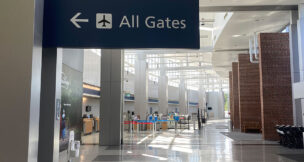Could Hyundai be the Port of Charleston’s next big export customer?
The largest development project in Georgia history is open for business and there could be something in it for South Carolina, too, says the president and CEO of the Palmetto State’s port system. Hyundai Motor Group Metaplant America on March 26 celebrated the official opening of a plant that will produce Hyundai, Kia and Genesis vehicles […]
Stock market today: Wall Street rises in another jittery day ahead of Trump’s tariff announcement
NEW YORK (AP) — U.S. stocks whipped through another dizzying day Wednesday in the final hours before President Donald Trump’s unveiling of the tariffs promised as part of his “ Liberation Day,” which could drastically remake the global economy. The S&P 500 rose 0.7%, but only after careening between an earlier loss of 1.1% and a later gain of 1.1%. […]
Trump is set to announce ‘reciprocal’ tariffs in a risky move that could reshape the economy
WASHINGTON (AP) — After weeks of White House hype and public anxiety, President Donald Trump is set on Wednesday to announce a barrage of self-described reciprocal tariffs on friend and foe alike. The new tariffs, coming on what Trump has called “Liberation Day,” are a bid to boost U.S. manufacturing and punish other countries for what he says are […]
Europe says that it holds a lot of trade cards on the eve of Trump’s tariff ‘Liberation Day’
BRUSSELS (AP) — A top European Union official warned the U.S. on Tuesday that the world’s biggest trade bloc “holds a lot of cards” when it comes to dealing with the Trump administration’s new tariffs and has a good plan to retaliate if forced to. U.S. President Donald Trump has promised to roll out taxes on […]
No batteries? Thinner packaging? US businesses look for ways to offset tariffs
NEW YORK (AP) — Gadgets sold without batteries. Toys sold in slimmed-down boxes or no packaging at all. More household goods that shoppers need to assemble themselves. These are some of the ways consumer product companies are retooling their wares to reduce costs and avoid raising prices as President Donald Trump levies new import taxes on key […]
If Trump tariffs linger, Va. maritime industry will feel pain, experts say
With President Donald Trump‘s self-branded “Liberation Day” anticipated to bring a rollout of new tariffs April 2 that Trump says will free the United States of dependence on foreign-made goods, many businesses and citizens are wondering what will happen next, with skyrocketing consumer prices and supply costs among their worries. On Monday, the president said he […]
Our View: Trump charts chaotic course in trade wars
Since taking office on Jan. 20 for his second term, President Donald Trump has steered the ship of state full speed on a seemingly chaotic course, mostly navigating an about-face from the Biden administration’s policies and only very occasionally zigzagging away from buffeting winds of public disapproval. In support of making progress on the administration’s […]
Canada is not our enemy, Kaine says
U.S. Sen. Tim Kaine, Virginia’s junior Democratic senator, feels strongly that Canada doesn’t pose a national security threat to the United States — a contrast to President Donald Trump, who has threatened the Great White North with tariffs as retaliation for what he says are insufficient efforts at keeping drugs from coming across its border. […]
US cities located in states won by Trump would be most hurt by Canadian tariffs, an analysis finds
WASHINGTON (AP) — The U.S. cities most vulnerable to a trade war with Canada turn out to largely be in the states that helped return Donald Trump to the White House — a sign of the possible political risk he’s taking with his tariff plans. A new analysis released Thursday by the Canadian Chamber of Commerce detailed […]
Copper prices have soared as the US threatens tariffs on the metal and China boosts its economy
NEW YORK (AP) — Copper prices have hit record highs as an ongoing trade war between the U.S. and its key trading partners threatens to squeeze supplies of the vital metal. Buyers in the U.S. have been stocking up on copper ahead of potential tariffs. Future prices for the base metal hit $5.21 per pound […]
Trump places 25% tariffs on auto imports
WASHINGTON (AP) — President Donald Trump said Wednesday he was placing 25% tariffs on auto imports, a move the White House claims would foster domestic manufacturing but could also put a financial squeeze on automakers that depend on global supply chains. “This will continue to spur growth,” Trump told reporters. “We’ll effectively be charging a […]
Canadian Prime Minister Carney says trade war is hurting Americans, noting consumer confidence
TORONTO (AP) — Canadian Prime Minister Mark Carney said Wednesday U.S. President Donald Trump‘s trade war is hurting Americans, noting that American consumer confidence is at a multi-year low. Carney also said the kinship that exists between U.S. and Canada is under more strain than at any point in the two countries storied histories. “His trade war is hurting American consumers [&[...]























